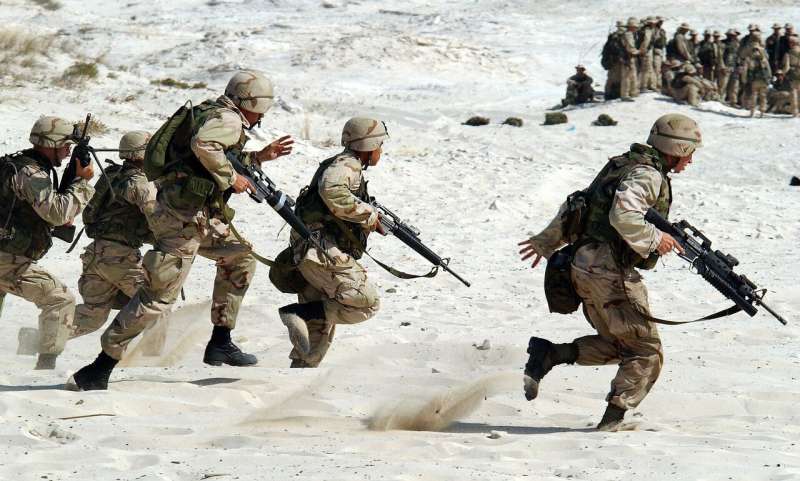This article has been reviewed according to Science X's editorial process and policies. Editors have highlighted the following attributes while ensuring the content's credibility:
fact-checked
trusted source
written by researcher(s)
proofread
Getting climate funds to conflict zones—a case for working with armed groups and local communities

Conflict-ridden and fragile countries are among the most vulnerable to climate change and least prepared to deal with it. They are largely excluded from climate adaptation programs and funding.
This is partly because funding is channeled through national governments, which might not be able to work in areas affected by conflict or beyond their control.
Civilians and armed groups alike are increasingly concerned about climate change. The international community, however, is doing little to address its impact in these vulnerable areas.
The Notre Dame Global Adaptation Initiative has identified 25 countries as most vulnerable to climate change and least prepared to adapt to its impact. Of these, 15 have been hit hard by conflict. This list includes Somalia, Central African Republic, Democratic Republic of Congo and Afghanistan.
By their nature, conflict-ridden areas have weak or no government structures. The current approach to climate adaptation does not include non-state actors and local communities, who might work more effectively in these areas.
With the COP28 climate meeting in Dubai, the issue of climate change adaptation in conflict areas has been in the news. A draft declaration by the COP presidency calls for immediate action and urgent funding for these vulnerable communities. The text is not legally binding, but it goes further than any previous COP statements on climate impacts in conflict areas.
I have spent over a decade researching conflict and insurgency. Working with colleagues from the Overseas Development Institute and the Geneva Graduate Instiute, I've investigated the failure of multilateral institutions to include conflict areas in their climate adaptation programs.
We reviewed existing literature on this. We identified gaps in climate adaptation efforts and funding mechanisms that would work in conflict areas. We argue for working with local communities and civil society as well as engaging non-state armed groups.
The conflict-climate gap
Conflict-affected countries receive significantly less climate adaptation funding. They get about one-third of the per capita climate financing compared to conflict-free countries. Adaptation programming and financing mechanisms are not designed for areas experiencing conflict or those beyond state control.
In some areas, non-state armed groups have stepped into the gap. In Myanmar, the Karen National Union operates its own departments focusing on land, forestry and wildlife conservation. The Kurdistan Workers Party (PKK) has incorporated environmental protection clauses into its internal codes of conduct. And in Somalia, Al Shabaab has imposed fines for cutting down trees and even banned plastic bags.
Elsewhere, such as in the Sahel, armed groups exploit the environmental drivers of conflict in propaganda and recruitment.
Armed groups take up the mantle of environmental protection for a complicated mixture of reasons. (They may also contribute to ecological destruction.) For most, it enhances their legitimacy with local populations, who are desperate for relief from the impact of climate change.
Where this is the case, it may present an opening for climate adaptation interventions. Armed groups control significant territories—often rich in natural resources. Their participation can be critical in taking wide-scale climate actions. We also know that armed groups seeking statehood or other forms of legitimacy are often willing to comply with international norms to gain positive recognition.
In short, there is untapped potential to save lives and mitigate the impact of climate change in areas under armed group control.
Our research suggests that this engagement can help build peace and reduce violence. Climate change is often portrayed as driving conflict or as a "threat multiplier" with impacts ranging from resource scarcity to displacement of people. But engagement with armed actors on the environment and climate change can also serve as a building block for peace.
This is especially true in countries like Colombia, where environmental factors contributed to the conflict. Environmental and resource issues are an often neglected aspect of preparing for peace talks.
Climate work in areas beyond state control is fraught with ethical, legal and practical dilemmas. For instance, certain laws that prohibit material support to designated terrorist groups can obstruct or complicate aid efforts.
There is always a risk that armed groups may just pay lip service to these norms, or that engaging with them could inadvertently further empower or legitimize them. Additionally, unlike government counterparts, armed groups and communities in these areas may lack the technical capacity to understand the ecological complexities involved in climate adaptation.
Addressing climate impacts beyond state control
These risks must be navigated carefully. But the urgent need for adaptation outweighs the potential drawbacks.
Climate adaptation actors do not need to engage directly with armed actors. Customary authorities, humanitarians and local peace builders can be intermediaries, ensuring interventions are appropriate and accepted by all.
Climate adaptation in conflict areas requires a different approach. At a minimum, it requires going beyond national governments, and directly engaging with conflict-affected communities. It also, to some extent, means devolving decision-making to communities themselves.
An urgent priority should be increasing climate financing for conflict regions. COP28's belated interest in conflict affected areas is welcome, but it doesn't go nearly far enough. This recognition must be followed by concrete policy and funding shifts tailored to the challenges of working in conflict areas and areas beyond state control.
Provided by The Conversation
This article is republished from The Conversation under a Creative Commons license. Read the original article.![]()





















